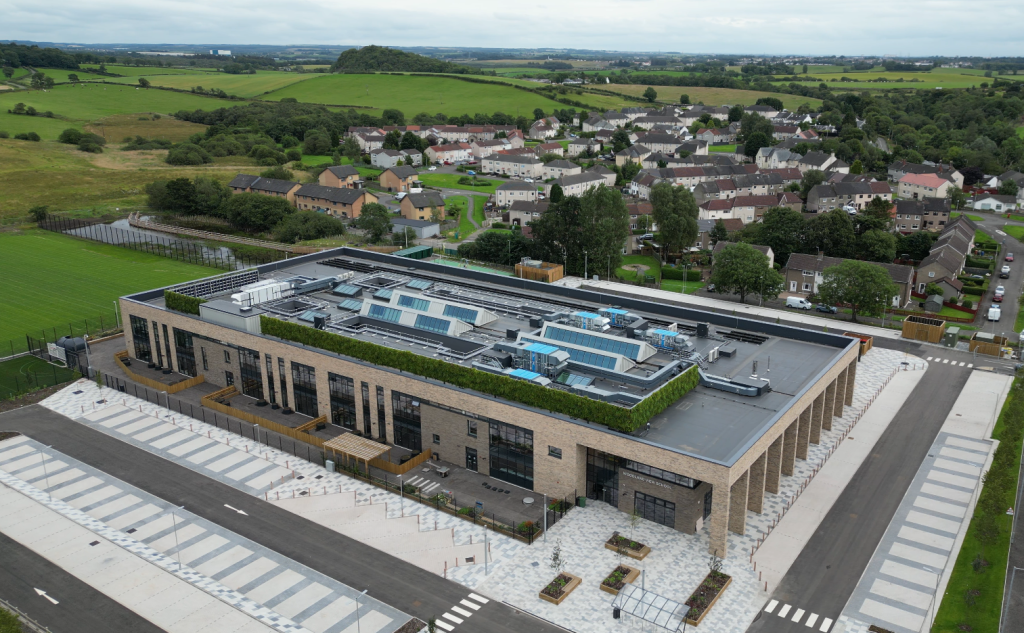Features - Business
Building a sustainable built enviornment – On the path to Net Zero

In the drive towards a net zero future, it is crucial to reduce environmental impacts from construction and infrastructure projects. Chris Boyle, Framework Director at McLaughlin & Harvey, explores how the sector can contribute to the transition to a net zero economy. By adopting carbon-conscious approaches in design and construction via the SCAPE procurement framework, striving for peak performance, and minimising carbon emissions, projects hold significant potential to advance our journey towards a sustainable future.

Chris Boyle, Framework Director at McLaughlin & Harvey
Scotland, with its 2045 net-zero target, requires public sector organisations to procure projects in a way that aligns with sustainability and climate goals. A critical instrument to help reach these goals is the Scottish Government’s Net Zero Public Sector Building Standard (NZPSBS). This standard places a strong emphasis on energy and carbon reduction in public sector projects, and is set to become mandatory by 2024.
Created to modernise and enhance the procurement and delivery of public sector construction projects, the SCAPE Scotland construction framework offers a strategic approach that delivers outstanding value in all facets of construction.
SCAPE Scotland and its partners, including McLaughlin & Harvey, recently launched a Life Cycle Delivery Guide, which presents the UK’s first framework procurement solution tailored to support the delivery and accreditation of net zero buildings. Covering new build and refurbishment projects, the guide demonstrates how SCAPE Scotland’s construction frameworks enable simple compliance with the Net Zero Public Building Standard in Scotland – from strategy to in-use performance verification.
With greener buildings proven to be more cost-effective in the long-term, the new guide will provide a clear pathway to net zero and better enable public sector organisations to make the business case for innovative design choices that lower carbon emissions.
The guide has been developed to provide an exemplary route for delivering to these targets, enabling clients and partners to make commitments to sustainability whilst setting ambitious, but achievable, objectives in response to the climate emergency. This is with a view that positive leadership will bring momentum within the construction industry as a whole and beyond.
Working together for a sustainable future
McLaughlin & Harvey has also been collaborating with the Scottish Government in the development of its public sector-led zero building standards. This initiative is being implemented on several LEIP (Learning Estate Investment Programme) projects, with some of the key metrics for funding being energy performance and carbon reduction. The progression from LEIP stage one to LEIP stage three involves transitioning to net zero, where energy efficiency standards are intertwined with carbon targets, promoting super-efficient buildings. These objectives have been aligned to and are supported by Scape through its Lifecycle Guide with the aim of producing an easy cost-effective method to procure public sector buildings and infrastructure.
The focus is now on circular economy principles, minimising waste, reducing energy usage, utilising low-carbon materials, and achieving sustainability throughout a building’s lifecycle. This commitment extends to future repurposing and refurbishment, aiming for a holistic whole-life perspective.
Since the introduction of public sector standards in early 2023, McLaughlin & Harvey has been actively involved in LEIP projects, modelling carbon assessments, and spearheading the integration of net zero principles. This holistic approach is forward-looking and aims to standardise building delivery to meet set targets and ensure a sustainable future.
Striking the right balance
Achieving an equilibrium between low carbon, energy efficiency, functionality and aesthetics is challenging as we contend with multiple competing factors. From analysis of several building types through carbon assessment tools the majority of carbon within buildings is concentrated in the frame and foundations, making these components the primary focus for carbon reduction.
Foundations and frames predominantly consist of concrete and steel. To reduce carbon impact, low carbon concrete such as GGBS concrete becomes crucial. Additionally, the choice between concrete, steel, or timber frames plays a pivotal role. Laminated timber structures are generally more carbon friendly but pose challenges when it comes to fire resistance and statutory compliance.
Reducing the carbon footprint in buildings involves various strategies. Low carbon concrete options exist and sustainable steel, produced using net-zero electric energy, offers viable alternatives with better strength to section size ratios, resulting in reduced material usage. This approach enhances environmental friendliness however, this comes at a cost premium with a limited supply chain. It is therefore essential to take an overview of all the available options and balance them with affordability and client value criteria.
When addressing carbon reduction, energy efficiency, functionality and aesthetics, certain principles come into play. The building’s Form Factor, size, shape and orientation, significantly impact efficiency. Design considerations must balance aesthetics, which often favour unique angles and shapes, with the need for efficiency. This can sometimes lead to a contradiction between appearance and energy efficiency.
Conventional designs with long, narrow, glass-heavy structures are less efficient. A shift toward more efficient design, although sometimes different in appearance, is essential. Efficiency doesn’t mean sacrificing aesthetics; it means embracing a holistic understanding of sustainable building practices.
Amidst the challenges of achieving net-zero construction, the SCAPE Scotland procurement framework serves as an inspirational example. It not only establishes fresh benchmarks but also motivates the entire industry to embrace a future committed to net zero goals.
For more information, visit: www.mclh.co.uk/scape-construction-framework
If you would like to read more stories like this, then please click here
Related Articles
More Features
- Building Britain: Ibstock ready to play their part in getting Britain building again
25 Jul 24
After Labour’s landslide win in July’s General Election, incumbent Chancellor of the Exchequer Rachel Reeves
- Housebuilding manifesto pledge scrutinised
20 Jun 24
We take a look at the response from around the sector.
- The drive towards electrifying the off-highway sector
10 May 24
The importance of electrification within the off-highway sector.






